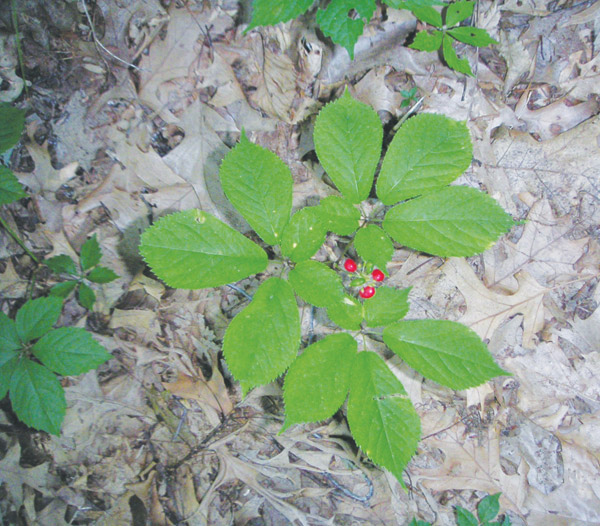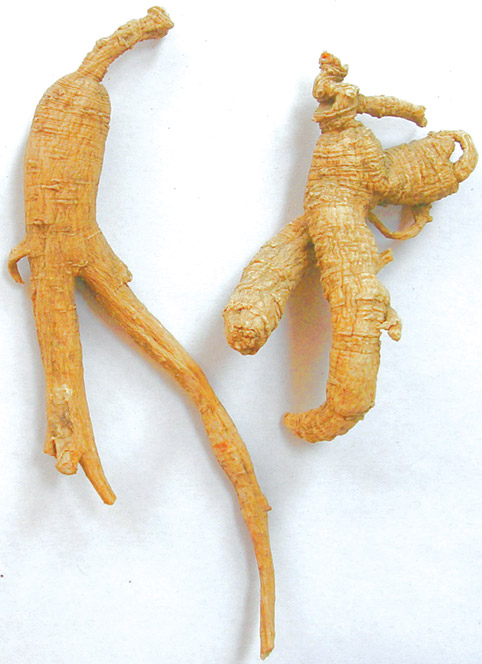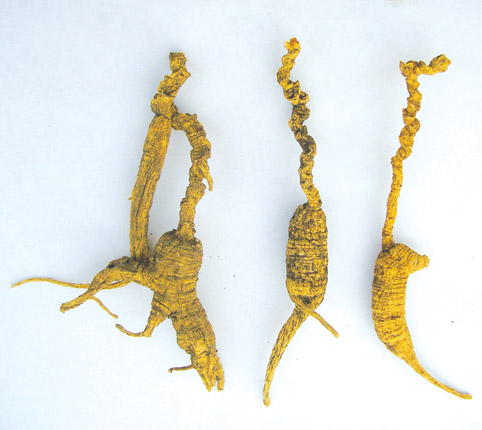 Outdoors: Natural Woods Grown Ginseng
Outdoors: Natural Woods Grown Ginseng
Written by Fong Lam
Translated and Organized by Luna Xu

Ginseng has been used extensively in traditional Chinese medicine for more than 5,000 years. It is regarded as the King of all Herbs, the perfect gift God has given to the human race. Ginseng is known to have a beautiful harmonizing effect on the coordination of the “qi” (spirit of breathing). It nourishes and strengthens the human body.
Many of the preventative and therapeutic values of wild ginseng have been confirmed by the scientific community. Research and clinical usage indicate that ginseng boosts natural immune functions, helps to prevent the common cold and alleviate insomnia. Ginseng is known to strengthen heart function, reduce cholesterol, and to even play a role in preventing and slowing the growth of cancer cells. Research findings on the preventative and therapeutic powers of ginseng often surprise those who regard it as a simple herbal root.
American wild ginseng is at the top of all types of ginseng in terms of quality. On average, the plants are 10 to 35 years old, and the roots have been naturally absorbing the top organic nutrients throughout this time, concentrating the ginsenosides that are believed to be the active ingredients in ginseng. American wild ginseng grows naturally in the dense native forests of the central, eastern, and northern United States.
The demand in Hong Kong and the rest of the Asian market is believed to be two to three times greater than the supply of American wild ginseng, yet the amount exported has been decreasing. In 2003, America exported approximately 75,000 pounds of ginseng to Hong Kong. In 2004, export decreased to 60,000 pounds. As demand continues to outstrip supply, market mechanisms dictate that wild ginseng will only become more valuable.
To protect the resource, the federal government classified wild ginseng as an endangered species in 1987. Rules and regulations have been issued to monitor and in some ways restrict the buying and selling of wild ginseng, including:
- Plants must be at least five years old before they may be harvested.
- Plants with two or fewer leaves cannot be harvested.
- Some states forbid the harvesting of plants with green, unripe seeds.
- Most states require that when ginseng is dug out, new seeds be planted below one inch of topsoil and covered with leaves.
- A ginseng license is required to harvest on public or private property.
- Firsthand, cross-state dealers must get permission from the state wildlife commission, obtain license and certification before conducting any business.
The responsible attitude the American government has taken in conserving wild ginseng is to be commended. Yet significant loopholes remain in the regulation process.
Much of the ginseng root currently being certified as “wild” in fact comes from woods-grown or woods-simulated cultivated plants. The certification of wild ginseng is largely based on self-reporting and the examination of limited samples by officials who may lack the training needed to distinguish wild-simulated from true wild root, especially when the two are mixed together.

Woods-simulated ginseng root sold for $60-80 on the market several years ago.
No one really knows how much native, wild ginseng remains, and because of this inaccuracy in counting how much is being harvested, it is difficult to form and enforce policies that effectively protect the resource while also allowing the harvest to continue, as has been admitted by the United States Fish and Wildlife Service:
“… The State conservation status ranking should reflect current conditions and understanding of that particular species. However, the amounts of wild-harvested ginseng reported annually by the state to DMA are not consistent with the numbers of plants and population sizes used for conservation rankings ... this is attributable to at least two factors. First, data are largely lacking on the occurrences of ginseng on private land. Second, much of what is exported as wild ginseng may in fact be some form of human-planted or (human)-grown ginseng, such as wild-simulated ...”
Luckily, there is a way for ginseng diggers and farmers to continue to benefit from the ginseng business while not only protecting but also enhancing the wild resource. This success depends on planting wild ginseng in a completely natural woods environment. Natural woods-grown is the only ginseng that equates with wild ginseng in both medicinal and economic value. Natural woods-grown ginseng could some day replace the income now generated by the digging up of wild plants.
We especially emphasize the “natural” part of natural woods-grown as opposed to woods-cultivated or cultivated. Natural woods-grown ginseng is the only kind that equals the wild in terms of value. The profit can be 5 to 10 times higher than from simply cultivating plants. Ten- to 15-year-old natural woods-grown might be worth from $400 to $500 a pound on the current market, and 8- to 12-year-old might sell for $300 to $400.

True wild ginseng, with long necks attached showing many years of slow,
natural growth was worth $500 or more.
The therapeutic values of natural woods-grown and woods-simulated also differ dramatically.
Natural woods-grown ginseng always comes from the seeds of wild ginseng or previous natural woods-grown ginseng. Alternately, fresh root can be transplanted. The key point is to leave the seeds and roots to grow naturally on their own. The use of herbicides, pesticides or fertilizers dramatically lessens the resemblance of cultivated ginseng to wild ginseng and also decreases the medical value.
It is important for farmers, diggers, buyers and dealers to be able to differentiate natural woods-grown ginseng from woods-cultivated ginseng. Here are some useful guidelines:
- Natural woods-grown ginseng has a relatively long neck; has 8 to 12 dents on its body; its size is relatively small, and it doesn’t weigh much.
- At the same age (typically 8 to 12 years for harvest), natural woods-grown ginseng has similar size and weight as wild ginseng.
- Natural woods-grown ginseng is also similar to wild ginseng in terms of color, smell, circular ridges on the root, and the soft, spongy fracture when the root is broken in half.
- Natural woods-grown has similar ginsenosides as same-age wild ginseng, which results in similar results in clinical testing.
Vast forests occur throughout American ginseng’s natural range (from 31 to 47.5 degrees north, from 75 to 98 degrees west), and much of this forest land could be planted in natural woods-grown ginseng. If the economic benefits of natural woods-grown ginseng are recognized, there will be no shortage of good places to grow it, and the income generated could have a significant positive effect on many rural Americans’ standard of living.
Ideal conditions for ginseng start with 90 percent natural shade on a forested hillside. Slope of hill on average should be 8 to 40 degrees. Organic layer of soil should be from 6 to 8 inches deep. Soil should be black and loamy, well drained with a pH of approximately 5. It is often best to plant natural woods-grown in areas where wild-ginseng had grown previously. Ginseng thrives in a climate with 40 to 50 inches annual precipitation. It requires several weeks of cold weather each winter to complete its annual growth cycle.
Ripe seed for planting should be collected between late September and late October. Eric Burkhart, the project leader at Department of Plant Sciences, University of Pennsylvania, recommends treating woods-grown ginseng or artificial wild American ginseng seed with a mix of 10% household chlorine and water; stir the seeds well, no more than 10 minutes, and then rinse with pure water. The chemical substances will dissipate through natural purification.
Clear the leaves from a small area. Do not turn or disturb the soil, because the top layer of the soil is the nutritious organic part, and you do not want to move that to the bottom. Plant one or two seeds in every 3 to 5 square inches. Cover the seeds with leaves. There is no need to water the seeds or care for them in any way. Just let nature take care of the seeds, the same as wild ginseng in the same location.
Patches of young, natural woods-grown ginseng can be thinned and transplanted to maximize the growing area. Dug the fresh, natural woods-grown ginseng and plant it back in deep soil so that the top of the root neck is under 1/2- to 1-inch deep. Plant every 1 to 3 square feet. (The greater distance allows for future seeds to fall with room to grow.) Water the root and cover with leaves. Then let it grow naturally.
In our experience, alternating between planting seeds and fresh roots is the best way to get the fastest growth. Five years after planting, a natural woods-grown ginseng plant may produce five to 10 seeds. These seeds fall naturally and have about a 33-percent chance of taking root. Each fall, the leaves cover these naturally sown seeds, and the growth speed is the fastest.
After 9 to 10 years, the annual income from an acre of natural woods-grown ginseng could be $30,000 to $50,000, maybe more.
After harvest, the dug roots should be stored loosely in paper boxes or paper bags, in a room with good ventilation. It is important not to store or ship ginseng in plastic bags, because plastic containers prevent ginseng from “breathing,” and this suffocation promotes mold.
From our experience, it appears that up to 2.5 percent of the ginseng harvest each year “dies” due to improper drying and storing methods. Waste like this can be totally avoided.
As ginseng planters and dealers, we encourage the USFWS and other relevant government agencies to encourage and subsidize natural woods-grown ginseng. The benefits are many, starting with the economic boost it could give rural American communities, not to mention improving our trade balance with Asian countries.
We also believe in the health benefits to people in general. We hope that all ginseng growers, diggers, buyers and dealers join us in this call for an open dialogue with the government authorities who may ultimately effect this positive change.
Contrary to the environment-friendly ways of natural woods-grown ginseng, cultivated ginseng is planted at much higher density. The use of herbicides, pesticides, and other chemicals not only hurts the plant’s therapeutic value, it also significantly decreases the commercial value. Intensive cropping also reduces the plant’s viability and increases pest damage.
Four- to five-year-old cultivated ginseng sold for $20-$30 a pound in 2006, and the market demand was very low. But natural woods-grown ginseng, at 10-12 years of age, sold for $400 a pound. If the increase in value were only proportional to age, the price would be around $50. However, the natural planting and growing method matters much more, as the real price differential for natural woods-grown is 5 times higher than the age-proportional difference.
Planting ginseng using the natural woods-grown method could not be simpler. No herbicides or pesticides are used, and the ginseng is left to grow in the wild. Little human intervention is needed, and the financial return is much higher than with cultivated ginseng.
Natural woods-grown ginseng fields are environmentally balanced, attractive, and can provide dependable income for years to come. They also provide a perfect alternative to the continued harvest of an ever-decreasing wild ginseng population. For all of these reasons, we encourage the appropriate government agencies to consider promoting the planting of natural woods-grown ginseng, including the subsidizing of loans to help ginseng farmers get started.
The era of herbicides, pesticides, and extensive chemical stimulation for the intensive cropping of ginseng has passed. Nowadays, people care more about their health and the nutritional value of what they put in their bodies. Natural woods-grown ginseng, whose quality and therapeutic value matches wild ginseng, whose growing method is purely organic, is bound to be the crown of the next generation of ginseng.